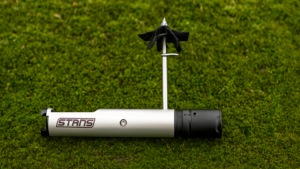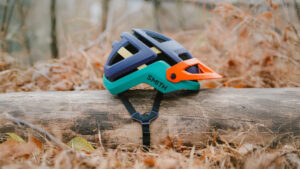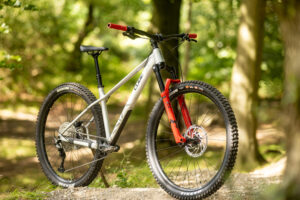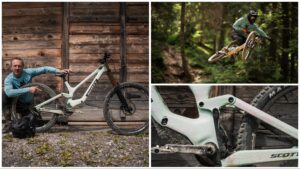Amflow and drone-gurus DJI have teamed up to create then PL Carbon with Avinox motor, a total hotrod e-bike with the power to peel your face off.
The DJI Avinox motor in Amflow’s PL Carbon Pro is obscenely powerful, but I found the lightweight chassis and trail bike attitude at odds with the extreme drive unit
The Amflow PL Carbon with DJI’s Avinox motor has put the cat among the pigeons. In 30 years as a mountain bike journalist, I can’t remember another bike that has stirred up so much hype and anticipation. The combination of outside industry disrupter, cutting-edge consumer tech, outrageous power, and an impressive weight at a competitive price has created a honeypot. And everyone is swarming around it, all asking the same question – how does it ride? That’s where I come in. I got the chance to ride the top end PL Carbon Pro recently on my home trails, with a fully production version of the motor – other reviews to date have been on older generation motors.

The Amflow PL Carbon Pro is a little vanilla in its styling, but it’s not a bad looking bike.
Amflow PL Carbon Pro need to know
- Carbon e-bike fitted ultra powerful DJI Avinox motor
- 105Nm torque and 850W power which can be boosted to 120Nm and 1,000W for 30 seconds
- Two battery options – 800Wh and 600Wh – with the latest cell technology
- Full carbon frame with 150mm travel and 160mm fork
- Claimed complete bike weights from 19.2kg (PL Carbon Pro in medium with 600Wh battery)
- Two spec levels with prices starting at £5,999
- Fast charging can renew the battery to 75% from empty in just 1.5 hours
- Bikes feature 2in OLED touchscreen integrated into the frame, onboard GPS, and Strava support
- Four power modes plus ‘intelligent’ auto mode that manages power depending on terrain
This is not a full review with the aim of seeing how it stacks up against the best e-bikes on the market – that will come as soon as we receive our test bike – but it gave me the chance for a solid set of first impressions on trails that I know well. Some of those opinions have been captured in their most raw form on the video we filmed on the same day. It’s embedded here, so do give it a watch.

That DJI Avinox is the beating heart of the Amflow PL Carbon Pro, and it leaves almost all the current leading motors in its wake.
Motor and battery
I’m sure you all know the Amflow/DJI’s headline stats from reading the initial news stories, but for the benefit of those that don’t I’ll go over them quickly here. As this is the rubber-necking element of the package. From a lightweight motor (2.5kg) that comes in below the likes of the Bosch Performance CX, CX Race, Shimano EP801, and Brose S-Mag (used in the Specialized Turbo Levo), the power is outrageous. 850w and 105Nm with an overboost function that supercharges this to 1,000w and 120Nm for up to 30 seconds. Which dwarves the most popular systems on the market with typically 85-90Nm and 600W peak power. Even the strongest units, such as Rocky Mountain’s Dyname 4.0 with 700W and 108Nm don’t come close.
Will this be the catalyst for a power arms race among motor manufacturers? Probably. Will that be a shot in the foot that leads to tighter legislation and a backlash against e-bikes? Let’s hope not, but with growing concern around e-bike battery safety and rule-flaunting by riders with conversion kits, it’s something to be mindful of as we stand at this crossroads.

That 2in touchscreen display can be configured in multiple ways and show countless data streams. Even current gear selection. And it’ll charge your laptop through a USB-C port at the top.
On the battery side DJI offers two options – an 800Wh and a 600Wh unit – both packed with the latest and most energy dense cells. This keeps the weights down to 2.87kg and 3.74kg respectively. These are integrated into the down tube and cannot be removed without detaching the motor first – another trick to get the weight down.
Big power packs then, but considering the power output, you could potentially drain that 800Wh unit in just an hour if you really worked the motor to its max. Both the entry-level and top end models come with the 800Wh unit, while the only option to get the 600Wh battery is the fancy PL Carbon Pro. Amflow doesn’t expect many customers to choose this option, even if it gets you to the headline weight of 19.2kg. Considering the power of the motor, and the modest £150 saving, we’d agree that you’d be mad not to opt for the largest capacity battery. Although fast charging means you can get from 0-75% charge in just 1.5 hours, meaning a quick top up at lunch could keep you rolling all day.
To control the system there is a high degree of flexibility. You can choose to run a wireless controller on the left, like most systems, or one either side, letting you scroll through various information screens on the 2in top tube OLED display with your right hand, and the five power modes (seven if you include walk mode and off) with your left hand. Or you can ditch both controllers and manage everything through the touchscreen display.
On the software side, DJi has packed the motor full of sensors to feed a rich stream of data to the system’s brain. It’s on par with the sophistication of the latest Bosch Performance CX that I rode recently, even if Bosch has over 10 years of experience developing its motors and software. There are inertia sensors for direction and acceleration, a torque sensor, cadence sensor, and speed sensor featuring 42 pick-up points, rather than the usual one. The brand is also keen to emphasise how it has used its experience and knowledge in the control of drones to develop a system that gives you full control of that massive power output, whatever the situation.

Neat features like the 42-point speed sensor help control all that power in a usable fashion.
While DJI and Amflow are new to the bike market, they are quick learners. Drawing on feedback from a wide range of sources, they are extremely agile, turning around updates to the motor and software in days and weeks, not the typical months or years experienced with the big suppliers such as Shimano and Bosch. For example, in July they received feedback about the motor rattle when coasting. By September they had found a fix, made a new batch of motors, and fitted them to the demo bikes. And it’s also clear that they are very serious about making this new venture work. This is not a flash in the pan.
Whether the motor proves durable and reliable is impossible to tell at this point. Nor can I give any impression of how Amflow will deal with after-sales care and warranty. But it’s clear that both are significant considerations for any e-bike customer, and will need to be taken seriously if Amflow/DJI are to outlast the initial hype.
I didn’t have time to delve into the app and configure settings, play with the screen data, anti-theft device, use the USB-C charging port on the display, or mess around with the Hill Hold, intelligent walk more, or Hill Start Assist functions.

A trunnion mount frees up space for a gear strap mount, but could have implications on shock durability. There’s also a bottle cage mount on the down tube.
Frame and geometry
I find it slightly odd that Amflow decided to take a lightweight approach to its chassis design, considering the power output of the motor. Take away the system weight of the motor and battery (6.24kg) from the large PL Carbon Pro I rode (20.6kg) and you basically have a 14kg trail bike. That’s pretty light in this day and age. Similar to the latest Specialized Stumpjumper 15. But thanks to the extra stability in the chassis, and additional weight, it’s possible to ride your typical e-bike much harder, and generate much higher forces through the frame, than a lightweight trail bike. Yes, the frame is category 4 rated, so should be built to take the abuse, but it’s still a 2.27kg frame (size medium), which is light. For example, the latest Orbea Wild frame, built for e-enduro racing and one of the lightest of its type on the market, still weighs 2.6kg. That’s over 300g additional carbon material in the frame. Amflow’s complete bike weight also includes Exo+ rear / Exo front tyres, carbon wheels, and a carbon bar. Uprate these for more aggressive riding and terrain and you’re going to end up at around 22kg – much more in line with other full power e-bike models. Going for such a svelte chassis makes for eye-catching headlines, but it remains to be seen if that will cause issues further down the line should heavier riders start adding longer forks, coil shocks, and reinforced tyres, then taking it beyond its intended use.

If I’m being picky, the seat tube could be a bit shorter and steeper, and the BB a bit lower. The large frame size is relatively small compared to SL rivals from Specialized, Orbea, and Cannondale.
Moving on to geometry, Amflow has mostly taken a conservative route. I didn’t get a chance to measure the bike (we’ll do this when we get our proper test bike) so for now I’ll have to rely on Amflow’s quoted figures. There are four frame sizes, running from M to XXL, with reach measurements at 452mm, 475mm, 500mm, and 525mm. This is the most controversial part of the sizing, in that there is no small option. My hunch is that this is because the 800Wh battery wouldn’t fit a smaller down tube. Unfortunately that does mean some riders will miss out, particularly as the seat tube lengths are not the shortest around.
At the other end of the scale, taller riders seem well catered for, although the fixed 445mm chainstay lengths will make the bike more rear-biased on the XXL.

Will this head badge become as well-known and desirable as the Specialized S, or Yeti big foot?
A 64.5º head angle is standard fare for a 150mm trail bike, the bottom bracket height is conservative at 345.5mm, and the actual seat angle is quite slack at 70º, even if the quoted effective number is pretty steep at 77º. This will help the Amflow feel more comfortable for covering ground while seated, even if the trade-off is a less effective riding position for tackling really steep climbs.
Both Amflow models will be sold as full 29ers, but the frame can be mulleted, with a flip chip at the shock yoke to compensate for some of the inevitable geometry change. In terms of the BB height and head angle, switching to a smaller rear wheel shouldn’t be a problem. Only the seat angle will take a hit the bike could do without. According to Amflow, you can also change the wheel size in the app, so you don’t have to suffer prematurely hitting the speed limiter.

Rubber frame protection complements the rattle-free motor to keep the Amflow PL Carbon blissfully silent.
A bottle cage mount sits low on the down tube, integrated rubber frame protection sleeves the chainstay, a flap covers the gap between chainstay bridge and motor, and I’m glad to see the fully internal cable routing enters the frame behind the head tube – no headset cable routing here.
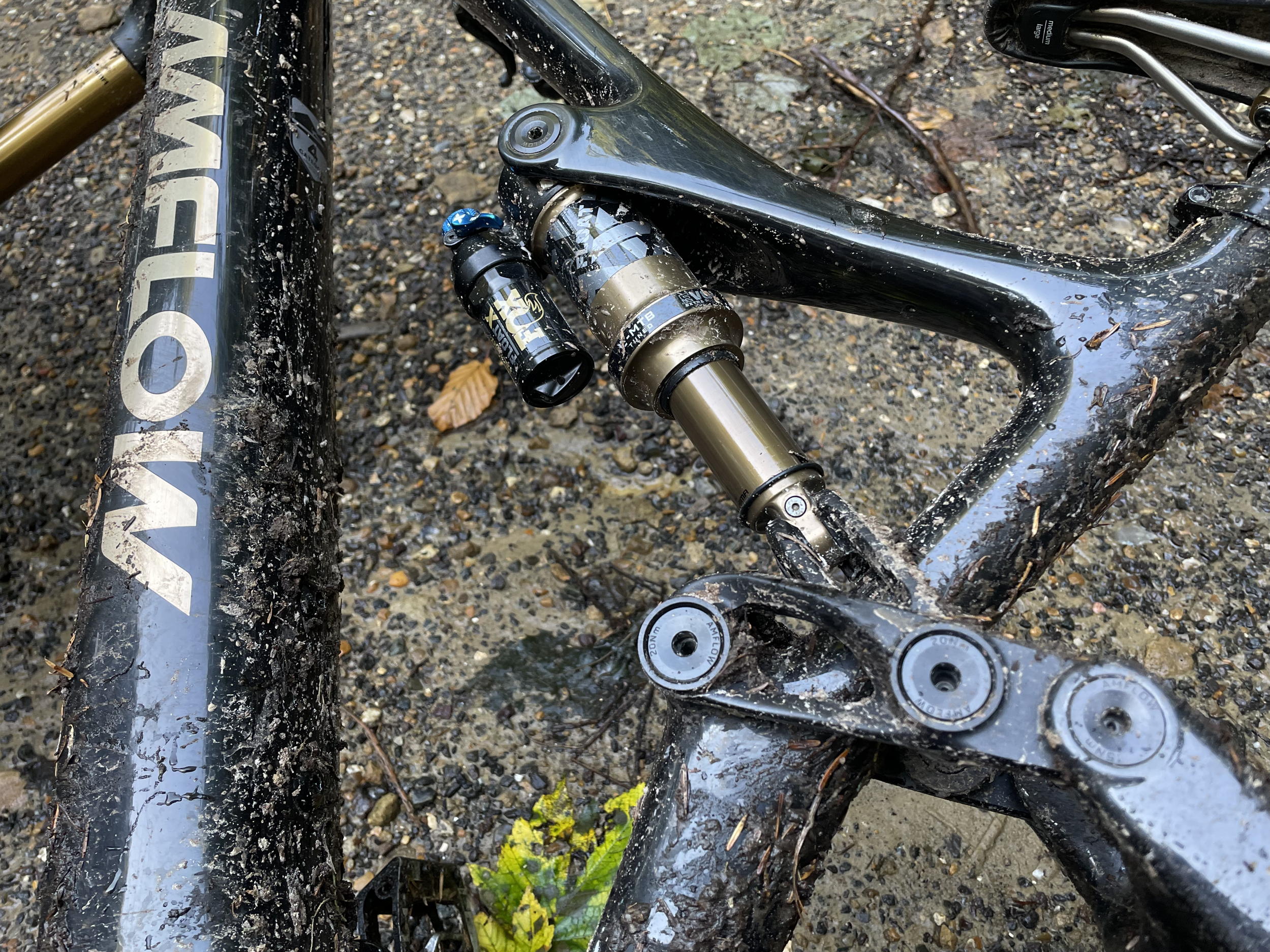
A flip-chip in the lower shock eyelet gives come compensation should you choose to fit a 27.5in rear wheel.
Suspension
Amflow has obviously been influenced by Specialized in the design of the PL Carbon frame. The four-bar linkage rear suspension uses a swing-link at the seatstays to drive the shock through a yoke extender. A trunnion mount reduces the effective eye-to-eye length of the shock and frees up some space under the top tube for a gear strap mount. But the rigid forward shock fixing coupled with the extra length of the yoke is likely to exacerbate any alignment problems, under hard cornering for instance, and could lead to premature shock wear. As such, this would be an area to keep an eye on.
There are precious few details on the Amflow’s kinematics, be that leverage, anti-squat, or anti-rise, but all I can tell you is that the Float X shock is custom-tuned by Fox and the leverage curve is on the progressive side.
A set-up chart gives recommended pressures for a variety of rider weights, and the bike even comes with a shock pump. According to those pressure charts, I should be running 178psi, but given the progressive nature of the suspension I ended up at 170psi, which equated to the O-ring at 18mm on the shock body, or 32% sag in the seated position with the saddle slammed.
Up front is the latest Fox 36 Float Factory fork with the new Grip X2 damper, which I’ve found extremely supportive, but on the harsh side, with a relative reduction in sensitivity compared to the new RockShox Charger 3.1 dampers. At 160mm of travel, the fact Amflow has chosen the slimmer 36 chassis underlines the point that this is closer in build to an SL e-bike (motor-excepted) than a full fat model.

Amflow’s tyre choice prioritises weight and range over outright grip.
Components
Amflow’s own carbon rims and carbon handlebar help keep the overall weight down on the PL Carbon Pro. The 30mm wide rims are shod with Maxxis tyres – an Assegai MaxTerra 2.5in up front with an Exo casing, and a Dissector MaxTerra 2.4in in Exo+ out back. It’s a choice that helps the bike on the scales, but won’t help your stress levels on the trails, particularly if they are rocky and fast. Those casings and compounds will maximise range, and the rear tread pattern is fast rolling, but traction on technical climbs is compromised. Mix in some moisture – which there was on the day I rode the bike – and the frustrating limitation on climbs is traction rather than grunt.
SRAM’s X0 wireless transmission keeps the whole thing rolling, with slow but accurate shifting. We will have to wait and see how the extra power and torque of the motor affect the durability of SRAM’s latest drivetrain.
Braking is handled by Magura’s MT7 Pro with 203mm rotors. Given the low weight of the bike, this is more than enough to rein in the Amflow, and Magura’s levers boast a light action and excellent modulation, making them a joy to use.
Fox supplies the equally light-action Transfer Factory dropper post. With a 180mm drop on the large frame size, I was able to set my seat height and get the saddle out of the way for descending.

The bike I rode had a gloss black finish instead of a cosmetic carbon weave with a clearcoat.
Performance
I got to ride a well-abused Amflow PL Carbon Pro with the latest motor iteration around my home trails on tracks I know like the back of my hand. It wasn’t a long ride – just 27km – and the trail conditions were slippery after a heavy rainstorm, but it was a good introduction to the bike. In 2 hours and 22 minutes of moving time, covering 600m of ascending, using Auto mode and a few hits of Boost, I used 51% of the 800Wh battery. My weight, including riding kit, is 80kg.
Climbing
Climbs? What climbs? The DJI Avinox motor flattens gradients like a bulldozer. It’s absurd how fast I could climb on the Amflow. Be that a fireroad, rooty singletrack, or a steep bank, this thing will sit at the speed limiter up just about anything, leaving rival full-fat e-bikes in its dust. On one fireroad climb with an 8% gradient and 50m elevation change, I just sat at 110rpm, putting out 250W, while the motor was at full chat (around 850W), giving a combined power of 1,100W. I was back at the top in a blink of an eye. There’s noise from the motor spinning, but it’s a subtle background hum rather than an annoying droning soundtrack to every climb.
While it was happy to spin, I didn’t need to rev the short 155mm cranks like a maniac to access that power. It gave me torque at significantly lower cadences, so I could get started on a steep power climb, or chess-puzzle my way up a technical section. That was just in Auto mode – not even using Boost or tinkering with settings in the app.

The top tube display has a USB charge port that will power up your phone and even your laptop or drone.
For another example of its power band, I lapped a short section of downhill, using the fireroad to scoot round to the top. I could do this without changing gear at all. There’s so much torque that I could drop onto the fireroad, almost come to a halt, and then accelerate up the climb. Which is one way to save on drivetrain wear!
Acceleration is also obscene. Two pedal strokes and I was up to full speed on singletrack, or entering a descent. Fluff a turn, or stall, and I could be back up to pace in the blink of an eye. The motor let me make mistakes and get right back in the game. For e-bike racing it would be a huge advantage.
In the wet conditions, it quickly became clear that the biggest limitation on the Amflow is the tyre spec. The rear Dissector simply couldn’t find traction on damp dirt.
Equally, a steeper actual seat angle would have allowed me to get more weight over the front end to keep it from lifting, while maintaining traction, when attempting really extreme gradients.
One thing the DJI motor didn’t give me was any kind of overrun when I stopped pedalling. I’ve been told that this is something that can be adjusted in the app, but I didn’t get time to play around with it.

Hit the rocket button and prepare for take-off!
Descending
The light weight and poppy, active suspension of the Amflow made it a dynamic and really engaging bike to descend on. Grip and traction is very good over minor exposed roots and choppy surfaces, with a pitter-patter response that encouraged me to load up the bike and boost over bigger obstacles and avoid heavier impacts. That progression helped keep the Amflow from harshly hitting into the bump stops, but running over 30% sag meant I was riding in a fairly narrow window of travel. Increase the pressure, reduce the sag, and the BB started to creep up and the bike started to feel a bit perched. With limited time available to fettle, it seemed like a good compromise, but I’ll look to revisit this when our proper test bike arrives.
It’s very easy to throw around, akin to an SL e-bike more than a heavier, full-fat model – much closer to a Specialized Levo SL, for example, than a Turbo Levo.
The sizing feels on the compact side, adding to the sense of being aboard a trail bike rather than anything skewed more to the enduro end of the scale, which made it easy for me to change direction and make line corrections. As the speed increases and the terrain becomes more chunky, the Amflow feels more fidgety. As a rider, I got busier, using more energy and concentration to keep it in check as the bike skipped around.
Load it up in a supportive turn, or land a jump and there’s a degree of chassis flex. At my body weight, this gave the bike a comfortable feel and helped reduce unwanted deflection hitting angled roots, but heavier riders might yearn for something more solid.
Quiet and graceful, the Amflow has no distracting cable rattle or chain slap noise, and the DJI motor is silent when coasting. At one point the battery did come loose inside the frame. The upper battery bolt can be accessed by removing the display, and sure enough, this had loosened just a touch. A quarter turn was enough to secure it and eliminate the rattle, but it was a touch concerning. Maybe a more robust battery mount might be appropriate.
Verdict
The definition of a hot rod is a small, light car with an inappropriately large and powerful engine, and the Amflow PL Carbon fits this description almost perfectly. The motor is ludicrous, to coin a phrase from another game-changing electrical vehicle, with so much power that it will pull a gap on any of the popular full power rivals on the market. Even the Rocky Mountain Dyname 4.0. Whether this is relevant or not is another question – since you’re only going to have to wait for your mates at the top of every climb – but it sure is childishly fun. Perhaps that novelty factor will wear off at some point, but for my short test ride it made me giggle every time I thumbed the controller into Boost. As long as there’s traction, the DJI Avinox motor can drag you up anything. It really is ridiculous. But the stock tyre choice severely limits the Amflow’s capabilities when you start taking on next-level climbing challenges. Park the motor for a moment, and the suspension and handling of the Amflow are surprisingly dialled for a first attempt. It’s a fun, capable bike to blast around on, and I found it just as enjoyable for shredding the descents as roosting the climbs. However, it’s not in the same build category as a Specialized Turbo Levo, Trek Rail, YT Decoy, or Canyon Spectral:ON. While those examples ride and handle like enduro bikes in all but name, the Amflow is a pure trail bike. A scrum-half rather than a prop. A running back rather than a defensive lineman. If you’re expecting an e-bike that feels like an unstoppable force on the descents, that can be hammered down enduro tracks without flinching, then you might be disappointed. If you want to dance down the descents and teleport up the climbs, then the PL Carbon will be a match made in heaven. Stay tuned for a full review coming soon.









